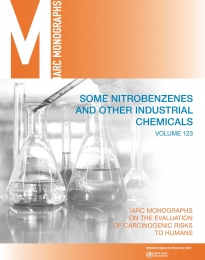
978-92-832-0161-8
978-92-832-0190-8
View The Lancet Oncology summary as HTML or PDF
French version of The Lancet Oncology summary (hosted by Centre Léon Bérard)
This volume of the IARC Monographs provides evaluations of the carcinogenicity of ortho-phenylenediamine dihydrochloride and its parent compound ortho-phenylenediamine, 2- and 4-chloronitrobenzene, 1,4-dichloro-2-nitrobenzene and 2,4-dichloro-1-nitrobenzene, 2-amino-4-chlorophenol, para-nitroanisole, and N,N-dimethylacetamide.
ortho-Phenylenediamine dihydrochloride is used in the manufacture of dyes, coatings, and photographic chemicals, while ortho-phenylenediamine is used in the production of pharmaceuticals and agrochemicals, and in dyes and pigments for colouring hair and furs. 2-Chloronitrobenzene is used to make colorants and various other chemicals. 4-Chloronitrobenzene is a chemical that is used in the production of agricultural chemicals, pharmaceuticals, paints, pigments, colorants, plastics, and paper, and in the treatment of textiles and leather. 1,4-Dichloro-2-nitrobenzene and 2,4-dichloro-1-nitrobenzene are intermediates in the manufacture of diazo pigments, agrochemicals, ultraviolet absorbents, and pharmaceuticals. 2-Amino-4-chlorophenol is a chemical used in the manufacture of pharmaceuticals and of dyes for textiles and other consumer products. para-Nitroanisole is used to make synthetic dyes used for cosmetics and other consumer products. Finally, N,N-dimethylacetamide is used in the manufacture of textile fibres, agrochemicals, pharmaceuticals, fine chemicals, coatings and films, and as a solvent for resins.
Exposure to all the agents considered may occur in different occupational settings and in the general population.
The IARC Monographs Working Group reviewed epidemiological evidence, animal bioassays, and mechanistic and other relevant data to reach conclusions as to the carcinogenic hazard to humans of environmental or occupational exposure to these agents.